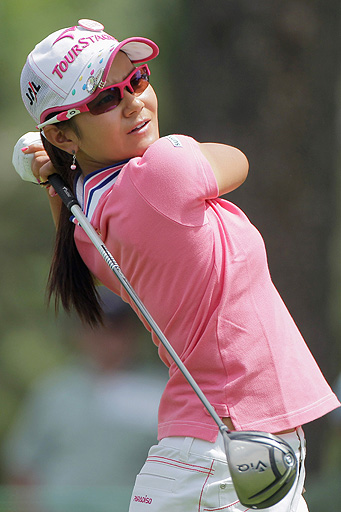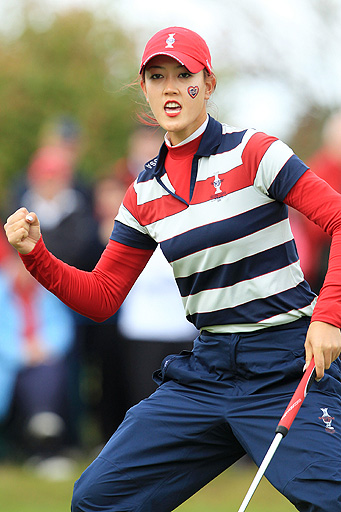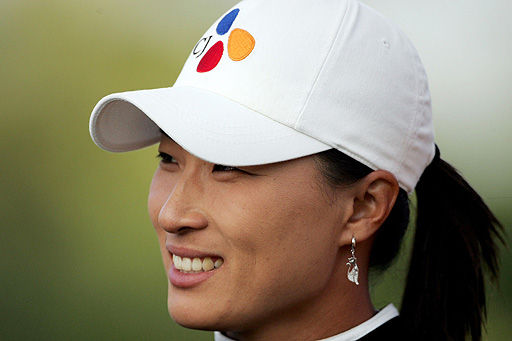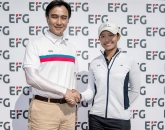 Shortly after the Europeans had snatched the Solheim Cup from the Americans at Ireland’s Killeen Castle, Mark Casey, Director of Operations at the Ladies’ European Tour, was assessing the impact. “Add this to the on-going work behind the scenes and it has to help,” said Casey. “The feedback from promoters and sponsors has been fabulous.
Shortly after the Europeans had snatched the Solheim Cup from the Americans at Ireland’s Killeen Castle, Mark Casey, Director of Operations at the Ladies’ European Tour, was assessing the impact. “Add this to the on-going work behind the scenes and it has to help,” said Casey. “The feedback from promoters and sponsors has been fabulous.
“We hope to be able to increase our prize-funds but, whatever happens, there will be no sitting back. Our big aim, now, is to win in the States in two years’ time against a team which will presumably include Lexi Thompson, America’s 16-year-old prodigy.”
In Casey’s eyes, September's victory was all the sweeter in that there had been suggestions that the Americans should be playing a "Rest of the World" side as opposed to a European team they had beaten at the three previous times of asking.
The eventual result – 15-13 – was far too close for anyone to risk the crack that the match should become Europe versus the Rest of the World. However, there is a strong feeling that this might be the moment for the introduction of a Europe versus Asia contest, one which would be taken every inch as seriously as the Solheim Cup itself. That is something that cannot be said of the now defunct Lexus Cup, a rather contrived affair that pitted Asia against an international side on an annual basis from 2005 until 2008.
“Our first priority,” said Casey, “must be to secure more full-field events for our members, but a match between Asia and Europe is certainly something we might look to develop.
 Because of the weather in Europe, we’ve had a long tradition of playing in Asia in the winter months and our members love going to that side of the world. At the same time, we have an ever increasing number of Asian players who enjoy coming to our tour, with a group of Chinese girls having just signed on for this year’s qualifying school.
Because of the weather in Europe, we’ve had a long tradition of playing in Asia in the winter months and our members love going to that side of the world. At the same time, we have an ever increasing number of Asian players who enjoy coming to our tour, with a group of Chinese girls having just signed on for this year’s qualifying school.
“As I say, if there are sponsors out there who are interested in such a match we would like to hear from them.”
Asian golfers, of whom 15 currently feature in the top 25 in the world, deserve this kind of a stage in the Western hemisphere. Their individual personalities would come to the fore, while everyone – including the all-important television networks – would enjoy their contrasting style of dress and play.
The fact that these great golfers have not been as fully embraced as they should have been outside of their own countries is, of course, not too different from the resentment visited on Swedish players when they first made their presence felt.
In the case of the Swedes, there were early accusations along the lines that they were not adhering to the R&A’s Amateur Status regulations. The amateur bodies in the United Kingdom wondered at the Swedish Federation and how, instead of having a firm dividing line between the amateurs and the professionals, the Federation actually helped the amateurs to make the switch. (The UK approach was more about administering the cold shoulder.)
All along the line, the Swedes discarded what they did not like in the British system. They never, for example, went down the ‘men only’ club route and instead sought a family environment, one where juniors could be seen and heard. (Intriguingly, though Annika Sorenstam has always been far too polite to make much of it, the fact remains when her family spent time in England in the late 1970s and early 80s, the then 10-year-old Sorenstam was not allowed to do as her parents in joining Royal Mid-Surrey on the grounds that she was too young.)
On a slightly different tack, the Swedes looked at women struggling with their long-irons before deciding that there had to be a better way. They then sent players like Sorenstam forth with a battery of higher woods. Laura Davies was just one who will tell you that she was more than a tad exasperated at the time. Though the low irons have always been Davies' forte, she suddenly found herself having to face up to the fact that Swedes were getting by perfectly well without using anything more taxing than a six-iron.
 The Swedes also took a new look at the mental side of the game. It was Sorenstam who, when she played in the annual Ping Championship at Moon Valley while still an amateur, left the whole of the golfing world open-mouthed when she said that her ambition was to shoot a 54. It transpired that Kurt Enhager, the Swedish psychologist, had told his young charges that two putts on every green were an unnecessary extravagance. They should be aiming at one.
The Swedes also took a new look at the mental side of the game. It was Sorenstam who, when she played in the annual Ping Championship at Moon Valley while still an amateur, left the whole of the golfing world open-mouthed when she said that her ambition was to shoot a 54. It transpired that Kurt Enhager, the Swedish psychologist, had told his young charges that two putts on every green were an unnecessary extravagance. They should be aiming at one.
When the Asians, with particular reference to the Koreans, first started winning in America in a big way, they were those LPGA members who complained, darkly, that the visitors were taking rather more than they were giving. Because their English still left something to be desired, they were unable – in some cases it was able but unwilling – to make the kind of conversation with pro-am partners which can so often lead to further sponsorships.
On an entirely different front, the LPGA home players queried whether Korean parents were doing the right thing by their daughters in keeping them on the practice ground for six or seven hours at a time.
Yet even the most determined fault-finders of the Swedish and Asian ways in time turned their attention to what they could learn from the new kids on the block.
Twenty or so years down the line, the English Golf Union accepted that the Swedes probably knew more than they did about golf development and signed on a Swedish performance director in Peter Mattsson. Though Mattsson is now going back to Sweden, he has contributed hugely to the advance of the English game over the last six years.
More recently, the girls from the LPGA have responded to the Korean advance by working harder themselves. Karen Stupples, winner of the 2004 British Open at Sunningdale, put it this way: “We are never going to work eight hours a day like the Koreans, it’s just not in our make-up. But what I can tell you is that where I used to do two or three hours’ practice a day, I’m now doing four or five.”
The Koreans, in turn, have not been blind to those areas where the Americans and others had the edge over them.
In Singapore, during the recent Asian Amateur championship, Won Ko, from the Korean Golf Association, was happy to outline the changes which have been made in the last couple of years. “We are focused on our juniors. But where, before, they spent all the time practising, they now do more studying. It is important to practise but our thinking today is that it is important, too, to spend time with friends and at school.
“Like in the other sports in Korea, our youngsters were practising too much. They were tired. Now, the Minister of Education has said that it has to be different.”
 So how do all those Korean parents who stand over their daughters on the LPGA practice grounds or, rather, the next generation of those parents, feel about this development?
So how do all those Korean parents who stand over their daughters on the LPGA practice grounds or, rather, the next generation of those parents, feel about this development?
“They accept that things are changing,” Ko said. “They have no choice.”
More and more, women professionals the world over are discovering what they have in common, rather than the reverse.
By way of speeding up the process, how about that fixture, Europe versus Asia?
Click here to see the published article.











